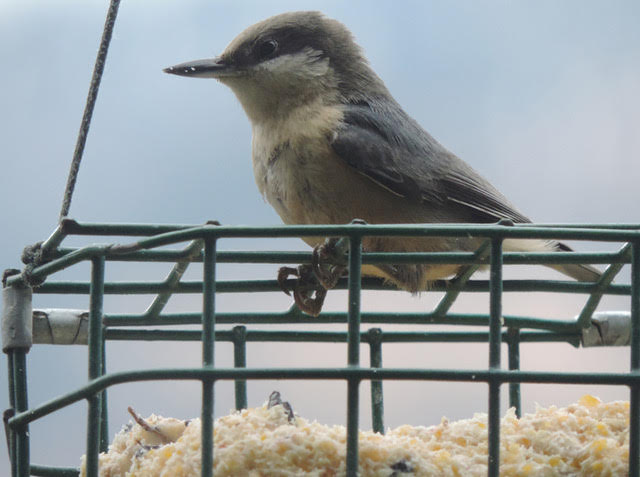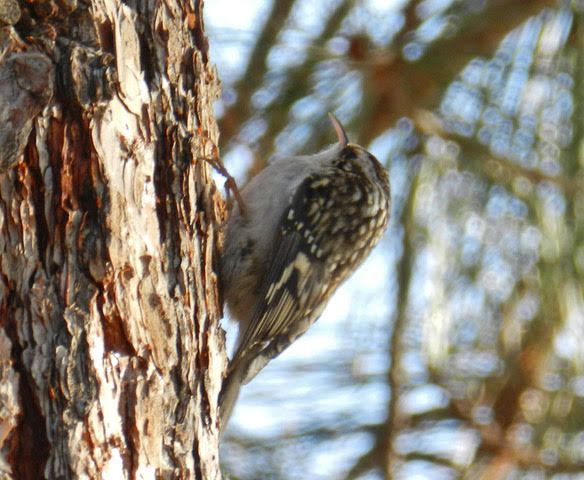At this time of year, when so many of our colourful summer breeding birds are winging their way southwards for the colder months, it is a pleasure to turn our attention to birds that stay here year round. This time let’s focus on our three species of nuthatch, White-breasted, Red-breasted, and Pygmy and the Brown Creeper all of which can be seen here at any time of the year, especially now and through the winter.
Nuthatches and creepers are bark specialists. They glean their food by working their way up or down (or along) tree trunks and branches, winkling out insects from the crevices in the bark. In general when you watch a bird feeding in this way, take note if it is going up or down; a good rule of thumb is that nuthatches go down, while creepers go up.

The largest nuthatch is the White-breasted Nuthatch, at 5 ¾”/~14.5cm. These birds have blue-grey upperparts, a white throat, cheek and belly, a conspicuous black eye and a long, pointed, chisel-like beak. The latter is perfectly adapted to find their food source. Beetle larvae are a favourite food. These birds typically spend more time probing the furrows and cracks in bark than other nuthatches. In winter, if you live where there are conifers, you might be lucky enough to have them visit your feeders or suet blocks. Eastern and western birds have quite different vocalisations, the western sounding to me like a soft ‘Chirr, chirr, chirr’. Raising one brood annually from April to June, from a clutch of 5 – 9 eggs, they use old woodpecker cavities, which they line with grass and hair.

Red-breasted nuthatches are smaller at 4 ¼”/ ~11cm. They are also more colourful, easily recognized with a blue-grey back, russet breast and belly, a bold black eyestripe and a bold black-and-white head pattern. The pointed chisel-like beak is smaller than that of the White-breasted, and this bird tends to be more aggressive. Frequently flocking with or near chickadees in winter, they often respond vigorously and vocally to a perceived predator. Flicking their short tails and their bodies at the top of a conifer, they will scold in their unmistakeable voice, ‘Yank, yank yank’, like a little tin horn. They occupy conifer woods and tend to be found at higher elevations in the west than in the east.

Our valley and the Nicola Valley are the only places in Canada where the endearing Pygmy Nuthatch is regularly found as they favour our Ponderosa Pines. As the name implies, this bird is our smallest nuthatch, 4 ¼”/ ~11cm like the Red-breasted, but stockier and with shorter wings. The upper parts are blue-grey and the top of the head a greyish brown. The underparts are a dusky beige and the beak small and pointed. Pygmy Nuthatches are more often heard than seen, as they frequent treetops. They make high-pitched calls and flock contact ‘pip’ notes. Like the other nuthatches, they nest in tree cavities, and will often favour nest boxes. In winter they roost communally for warmth; one friend of mine watched 22 of them squeeze out of a small decorative bird box one cold winter morning! They always seem cheerful somehow and are delightful to watch if you live in suitable habitat or visit it frequently. Young birds from the previous year’s brood frequently help to raise the next year’s young.

Brown Creepers are widespread across Canada in summer but remain during the winter only in the extreme west and north and in Atlantic Canada and Newfoundland. They are about 5 ¼”/~13.5 cm in size, with a mottled brown back, white throat, breast and belly and a distinctive very thin, downward-curving beak. The tail is longish and forked, enabling the bird to brace itself against the tree trunk as woodpeckers do. As they forage on the bark for insects, they fly to the base of a tree, hop up onto the trunk, and gradually work their way upwards. They then fly to the base of a nearby tree and repeat the process. This enables them to find insects other birds that feed downwards, like nuthatches, have missed. Insects, larvae, eggs, aphids and so on are their prey. Their nest is often concealed under a flap of peeling bark and is hammock-shaped. They raise one brood a year between May and July. Their vocalisations are very high-pitched and easy to miss, a jumble of thin whistles and abrupt ‘tswit’ notes. Summer months see them at higher elevations to breed but in winter they descend to the valley floor and will feed on deciduous as well as conifer trees. They also come to suet blocks for some extra nutrition.
Birding doesn’t stop when breeding does. So enjoy these fall and winter residents until the breeders return again in the spring. Cooler weather does have its compensations.
Pam Laing
Okanagan birder







Geraldine Clark
Enjoyed your blog – and now will know how to identify Creepers form Nuthatches. Also nesting habits and trees they favor. I have not seen them for years as we no longer have Ponderosa pines around – what a shame.
Joani
Thanks Pam, I learned a good bit!!
Penny Gambell
Thanks for the naming of these birds. I grew up here and always thought the Red-breasted Nuthatch was a chickadee. I have often seen them without the red breast here. When I was young in the 1950’s and 1960’s I remember seeing lots of pale yellow and black meadowlarks who whistled a pretty tune that we thought sounded like “this place seems quite suitable”! We also saw bluebirds and lots of hummingbirds. The beautiful pheasants that filled our fields are very difficult to see now.